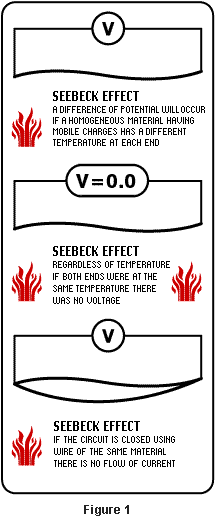|
Platinum Resistance
Thermometers
RTDs are based on the fact that the resistance of metal wire increases with temperature.
Practical devices are made of metals that exhibit relatively large temperature coefficients of resistance.
The obvious and best choice is platinum because it has a relatively high resistivity, is very stable, and does not alloy into another material, regardless of the atmospheric conditions to which it is exposed.
 When RTDs first appeared, the only practical way to make them was to wind a fine metal wire around a nonconducting mandrel.
Platinum is expensive, and the ability to draw this soft metal into wire was not nearly so refined as it is today.
As a consequence, RTDs have been made from a variety of metals, the most popular of which were copper, nickel, and nickel iron alloys.
Although all these metals have positive temperature coefficients of resistance, each has different characteristics.
Their temperature coefficients of resistance differ in magnitude and linearity, and the resistivity of each is different.
When RTDs first appeared, the only practical way to make them was to wind a fine metal wire around a nonconducting mandrel.
Platinum is expensive, and the ability to draw this soft metal into wire was not nearly so refined as it is today.
As a consequence, RTDs have been made from a variety of metals, the most popular of which were copper, nickel, and nickel iron alloys.
Although all these metals have positive temperature coefficients of resistance, each has different characteristics.
Their temperature coefficients of resistance differ in magnitude and linearity, and the resistivity of each is different.
 Copper, the most linear but with the lowest resistivity, was widely used by the manufacturers of electrical power generators and transformers.
Its low resistivity led to the 10Ω copper RTD. Nickel and nickel–iron alloys were used because they exhibit higher temperature coefficients and the wire is both much easier to work with and less expensive than platinum.
The nickel–iron alloy became popular because the material is made especially for temperature sensor use and its high resistivity supported higher resistance RTDs.
The definition of pure nickel has changed over the years as the ability to produce higher purity grades improved.
While nickel and the nickel alloy are relatively stable, they do not rival platinum.
The materials are not interchangeable batch to batch and operation is restricted to 260°C.
The added processing required to attain reasonable interchangeability adds more cost than can be saved by using the lower cost resistor material.
The use of the nickel materials in new sensor designs persists because it may be formed by chemical etching into useful configurations.
The bottom line is that platinum is much more stable, and when it comes to long–term measurement of temperature the others are not even close.
Copper, the most linear but with the lowest resistivity, was widely used by the manufacturers of electrical power generators and transformers.
Its low resistivity led to the 10Ω copper RTD. Nickel and nickel–iron alloys were used because they exhibit higher temperature coefficients and the wire is both much easier to work with and less expensive than platinum.
The nickel–iron alloy became popular because the material is made especially for temperature sensor use and its high resistivity supported higher resistance RTDs.
The definition of pure nickel has changed over the years as the ability to produce higher purity grades improved.
While nickel and the nickel alloy are relatively stable, they do not rival platinum.
The materials are not interchangeable batch to batch and operation is restricted to 260°C.
The added processing required to attain reasonable interchangeability adds more cost than can be saved by using the lower cost resistor material.
The use of the nickel materials in new sensor designs persists because it may be formed by chemical etching into useful configurations.
The bottom line is that platinum is much more stable, and when it comes to long–term measurement of temperature the others are not even close.
|
|
The ability to purify platinum and knowledge of its characteristics led to the early development of very stable, albeit very expensive devices.
Today, the lower cost of manufacturing platinum wire eliminates any price justification for use of the other metals. In fact, platinum now costs less in most cases.
The development of thin film technology has resulted in the production of reliable platinum RTDs at costs so low that wire-wound platinum devices are used in a very small minority of new situations.
The standard of 100Ω at 0°C arose quickly and a few variations based on the achievable temperature coefficient of resistance became popular.
 The technology of sputtering thin film platinum devices resulted in the addition of controlled amounts of impurities and/or stabilization exposures in the range of 900°C to control the temperature coefficient of resistance.
Platinum RTDs are controlled worldwide to a universally accepted standard incorporated in DIN 43-760 and IEC 751, which are essentially identical.
The technology of sputtering thin film platinum devices resulted in the addition of controlled amounts of impurities and/or stabilization exposures in the range of 900°C to control the temperature coefficient of resistance.
Platinum RTDs are controlled worldwide to a universally accepted standard incorporated in DIN 43-760 and IEC 751, which are essentially identical.
 Progress in semiconductor manufacturing technology has been applied to the manufacture of thin film RTDs and has resulted in very inexpensive and reliable components.
Today's thin film platinum RTDs are well matched to the supporting substrate. Their failure rates are comparable to those achieved by the most reliable wire–wound units.
The mean time between failures achieved in practice appears to have more to do with the packaging of the devices than with the process used in their manufacture.
Progress in semiconductor manufacturing technology has been applied to the manufacture of thin film RTDs and has resulted in very inexpensive and reliable components.
Today's thin film platinum RTDs are well matched to the supporting substrate. Their failure rates are comparable to those achieved by the most reliable wire–wound units.
The mean time between failures achieved in practice appears to have more to do with the packaging of the devices than with the process used in their manufacture.
 The development of thin film RTDs has progressed to incorporate practical cap-abilities necessary for unrestricted use:
The development of thin film RTDs has progressed to incorporate practical cap-abilities necessary for unrestricted use:
  Strong lead attachment
Strong lead attachment
  Tightly controlled temperature coefficients including the effects of material bonding on alumina supports
Tightly controlled temperature coefficients including the effects of material bonding on alumina supports
  Automated trimming to resistance tolerances that are the same as those for manually trimmed wire RTDs
Automated trimming to resistance tolerances that are the same as those for manually trimmed wire RTDs
  Thin film RTDs packaged in standard packages similar to semiconductors to support automated manufacturing
Thin film RTDs packaged in standard packages similar to semiconductors to support automated manufacturing
 Thin film RTDs are inexpensive, stable, reliable, small, fast, accurate, and manufactured to the same internationally recognized standards by every manufacturer in the world who makes these devices.
Thin film RTDs are inexpensive, stable, reliable, small, fast, accurate, and manufactured to the same internationally recognized standards by every manufacturer in the world who makes these devices. |
|
Summary
Semiconductor based devices, thermistors, and ICs are well suited for use as component parts of electronic apparatus.
The practice of packaging them in metal housings with threaded fittings would never have become established if today’s platinum devices had existed 20 years ago.
RTDs and thermocouples are packaged with threaded fittings and connection heads and thermowells in order to facilitate their replacement upon failure.
 Thermocouples are exposed to the harshest environments and highest temperatures and are therefore prone to failure at rates sufficiently high as to continue to justify the common industrial configurations.
Thermocouples are exposed to the harshest environments and highest temperatures and are therefore prone to failure at rates sufficiently high as to continue to justify the common industrial configurations.
 When transistors first appeared, our vacuum tube mentality told us to expect failures and mount them in sockets.
The failures proved to be mostly failures of the sockets and equipment reliability soared as the sockets were eliminated.
When transistors first appeared, our vacuum tube mentality told us to expect failures and mount them in sockets.
The failures proved to be mostly failures of the sockets and equipment reliability soared as the sockets were eliminated.
 RTDs have advanced so far in the past decade that the practice of packaging them like thermocouples will gradually disappear.
Most failures associated with current RTD installations are failures in the interconnecting hardware. As manufacturers learn to trust the modern RTD they will learn to mount them permanently in locations that will facilitate optimum operating efficiency at the expense of easy maintenance.
RTDs have advanced so far in the past decade that the practice of packaging them like thermocouples will gradually disappear.
Most failures associated with current RTD installations are failures in the interconnecting hardware. As manufacturers learn to trust the modern RTD they will learn to mount them permanently in locations that will facilitate optimum operating efficiency at the expense of easy maintenance.
 Considering that available, low–cost ICs can accurately digitize, in engineering units, the resistance of platinum RTDs with more than sufficient resolution to achieve all the accuracy available, it no longer makes any sense to sacrifice the universal interchangeability and stability of the RTD for the increased sensitivity of the semiconductor based devices.
Manufacturers who are slow to recognize the significance of this will find themselves at a serious competitive disadvantage.
Their equipment will not only cost more, but it will also be less reliable.
Considering that available, low–cost ICs can accurately digitize, in engineering units, the resistance of platinum RTDs with more than sufficient resolution to achieve all the accuracy available, it no longer makes any sense to sacrifice the universal interchangeability and stability of the RTD for the increased sensitivity of the semiconductor based devices.
Manufacturers who are slow to recognize the significance of this will find themselves at a serious competitive disadvantage.
Their equipment will not only cost more, but it will also be less reliable.
 While there will always be certain applications that require the fastest or most sensitive component regardless of cost, it is clear that in the temperature range from -200°C to 600°C the use of any contact temperature sensor other than a platinum RTD will be increasingly difficult to justify.
While there will always be certain applications that require the fastest or most sensitive component regardless of cost, it is clear that in the temperature range from -200°C to 600°C the use of any contact temperature sensor other than a platinum RTD will be increasingly difficult to justify.
 |
Irwin Bluestein is National Sales Manager,
RdF Corporation. ©RdF, 2003, edited.
Original Publishing: SENSORS, January 1999,
AN ADVANSTAR PUBLICATION |







